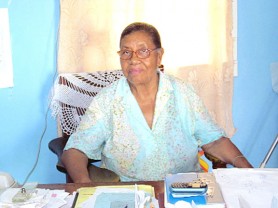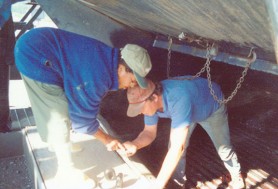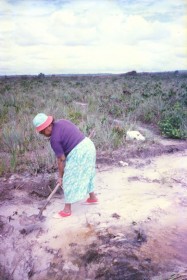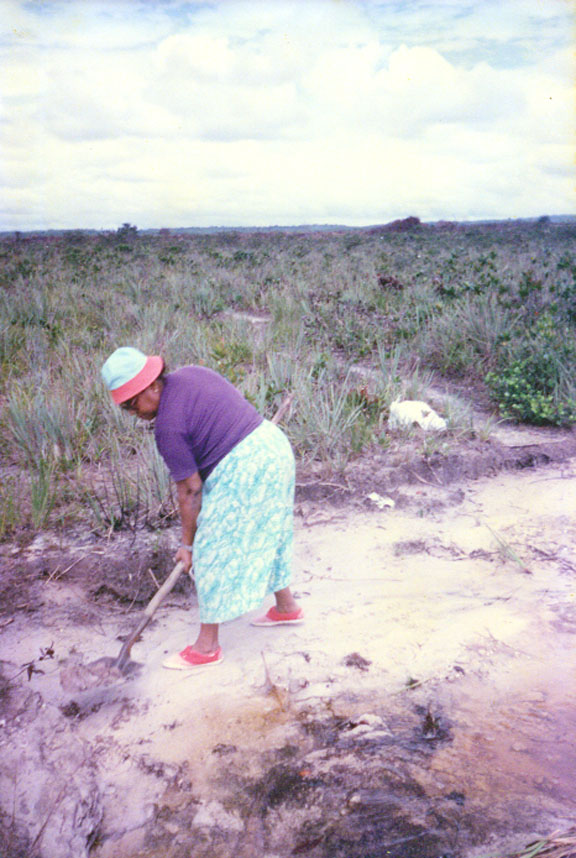By Candace Phillips

A miner, former member of parliament and outspoken mining advocate, Cyrilda De Jesus is a giant in her field despite her diminutive stature.
Her achievements were brought into focus earlier this month when Commissioner General of GGMC William Woolford announced that as part of the activities to mark Mining Week a special Commemorative Stamp featuring De Jesus would be unveiled. This will be done on the 10th Anniversary of Pork-Knocker Day. “She will represent the female porkknocker and she started small with warishee, batel, and sieving herself, jigging and so on herself and working the line and everything. Now, she has got people doing it for her,“ Woolford observed.

Postmaster General Henry Dundas said that details on the launch and the denomination of the stamp have not been finalised as yet. However, he said the Guyana Post Office Corporation was happy to work with the GGMC on the project.
De Jesus said she is happy about the accolade. “As a small person and they chose me, I feel great,” she said, while seated behind a desk in her home office, after nearly four decades in the mining industry. She added that she was grateful for being recognised.
She is the picture of a simple woman. The only signs of her mining activities are engine parts in her office and a radio nearby. Her jewellery is made up of simple pieces. “It was not an easy life,” she said.

De Jesus’ are humble beginnings that can be traced to Waini, Region One, where she was born on February 9, 1937. She was the fourth of the seven children. Her mother was of Arawak/Spanish ancestry while her father was an Afro-Guyanese. She credits her early interest in mining to him; he was a porkknocker and a ranger and she recalls being around to see declarations of gold and diamonds from other miners. The family moved to Mabaruma but at age 14 years, she had to leave school since her father said he could not afford to send all of his children to school.
Enterprising as ever, De Jesus boasted that by age nine she could sew a dress by hand. In the period after school and her marriage, she worked as a domestic help for several families while doing some amount of sewing on the side.
She had a desire to learn about her country and realised that she had to “get out there.
“I did not want to sit down and do nothing.”

She became a porkknocker when she separated from her husband in 1964, and launched into a world with which she has now been intimately linked.
She left Waini to go into the ‘backdam’ with Donald Wilson who employed her as a cook. She recalled going onto the pontoon at nights where she was taught by the workers how to ‘jig’ as well as other mining-related processes. She later travelled to Georgetown and was offered help to set up a 3” suction dredge by a friend and as she said, “the real porkknocking began.” The dredge was set up at Karisparu, Region Eight.
She spoke of the hardship to set it up: “You had to fetch everything. There was nobody to fetch in anything for you.” She said that she and her two workers had a 28-mile trek to their camp site, lugging with them all their equipment. It took a week. She said that as the cook, she had to carry all her pots and supplies, weighing about 80 pounds, in a warishee (an indigenous carrying basket which is strung across the back and tied to the forehead).
After this trek, they realised that they did not have a boat and the water was high. A decision was made to make a corial (a boat), this was done by digging out the inside of a tree and then burning it. They worked at the site for a period then they moved.
At Sokaika Creek, Region Seven she spent a few months prospecting the area. Once again they were faced with having to fetch everything. She said that after this period, she was tired and sore from carrying the warishee.
However, shortly after, she was able to buy her own 6” dredge with money she had saved over the months she had worked. She set up her pontoon at Ekereku, Cuyuni, Region Seven. She said in those days, the price of gold was low so she did not make much on her production.
It was after this that she decided to go back to Karisparu but after three months she left again as Monkey Mountain was beckoning her. She prospected in the area but left after a few months.
At every area she worked, she said, she had to trek to camp grounds fetching her warishee.
While she tried working at a few areas, her true love was for Ekereku, because of the scenic mountains and fresh water. It was during this period that she acquired several claims at the area. She said it was the realisation of a dream to have her own claims instead of having to pay royalties to someone else.
While starting out may have been difficult, she has no regrets, it seems like a life she was destined for and one she easily identifies with. She said that she has worked with many men and they have no problem having a woman for a boss. “They respect me because I am fair,” she said. Laughingly she added, “They does only tell me I racial, cause I does like to have Amerindian guys around me.”
In 1982, she along with Eugene Adams and
his brother formed the Guyana Gold Miners Company. The main thrust of the company was to control the amount of gold on the local market. Under the directive of late former president Forbes Burnham, they were to work with miners to encourage them to sell their gold to the Guyana Gold Board.
She said as a result of their work, they were able to help the government generate foreign currency. However, to allow for greater autonomy, the company was registered and became the group now known as the Guyana Gold and Diamond Miners Association (GGDMA). De Jesus was then elected to the leadership of the association–a position which she held for 20 years. She opined that it was now time for the younger miners to take up the mantle. Nevertheless, the papers on her desk are an indication that she has not been fully divorced from carrying out the work. “I came off but they still trying to fit me in somewhere,” she said. She now functions as a trustee of the association.
On December 23, 1985, she took the oath of Parliament. Speaking of her days as an MP, she said it was enjoyable. “I learnt, learnt so much.” She said it was a significant achievement since she was an early school leaver and was able to learn. “You are never too old to learn.”
She credited, “Mr Henry,” former chief mines officer and a surveyor with teaching her everything she knows. “They used to be at my back, you have to do this or do that,” she said.
From her marriage, she has one daughter, three grandchildren and five great-grandchildren. She has not remarried. While she has tried to lead a life outside the association, she said she is looked at to speak out on issues affecting the mining industry. “No one wants to go out there and talk. I don’t know why these people are so afraid,” she said, while emphasising that miners should be able to manage their own business in the right way. “I would like to see mining go ahead, small and medium scale must be able to earn but they have to adjust themselves to the law.”

